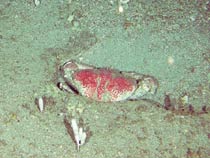 |
|

|
First
View - Giant Crab at home on the Slope
CSIRO Media Release
November 26, 2003 |
| Scientists
have had their first view of the habitats
and ecosystem that support Australia's
largest commercial crab - the "giant
crab" (Pseudocarcinus gigas).
A
series of five surveys are planned
in waters of 150-350 metres depth
to assess the seabed habitats of the
giant crab at the edge of the continental
shelf around Tasmania. The pilot survey
was completed on the State's east
coast earlier this month in a collaborative
project between CSIRO Marine Research
and the Tasmanian Aquaculture and
Fisheries Institute (TAFI), University
of Tasmania.
"We
used a specially designed camera platform
towed behind a research vessel to
provide a tremendously exciting first
look at the type of habitat that supports
the giant crab fishery," says
project scientist, Dr Alan Williams,
from CSIRO Marine Research in Hobart
"We were as pleasantly surprised
by the extremely good detail provided
by the new cameras system as we were
by the range of habitats we were able
to film," he said. Seafloor features
observed ranged from large plains
of muddy sands supporting communities
of small invertebrate animals, to
ridges, and rock outcrops exceeding
20 metres in height. |
|
The
project includes a study of the distribution
of the giant crab in relation to habitat
features, evaluating ecosystem links
with the seabed habitats and assessing
the abundance, sex, condition and
size of the giant crabs. "The
crab trap fishery is a unique Australian
fishery, and based in an environment
and depth that, until now, we have
not had the technology to study in
this way," says project leader
Dr Caleb Gardner, from the Tasmanian
Aquaculture and Fisheries Institute
(TAFI).
"Sustainability of all Australian
fisheries is reliant on healthy habitats
and ecosystems and this project seeks
to identify the characteristics of
the system and what, if any, impacts
are occurring as a result of fishing
activity," Dr Gardner said.
|

A
giant crab revealed at 350 metres in
the survey
of the continental slope north east
of Tasmania.
Photography courtesy CSIRO.
|

The video camera system designed and
built by
CSIRO for habitat surveys.
Photography courtesy CSIRO. |
The long-lived, slow-growing giant crab is highly sought after especially in the Asian market. Although mostly sold at around 4kg and with a shell of 20 cm or less, the crab reaches a massive 13.5 kg. The Tasmanian pot fishery expanded rapidly in the 1990's and is now targeted across southern Australia in Victoria, Tasmania, South Australia and Western Australia.
Funded by the Tasmanian fishing industry and the Department of Primary Industry, Water and Environment, the project is a joint study involving the Tasmanian Aquaculture and Fisheries Institute, CSIRO Marine Research, and the crab trapping and finfish trawling sectors.
|
For more information on ocean assessment techniques and how the scientist can make these discoveries read the CSIRO Fact sheet: http://www.marine.csiro.au/LeafletsFolder/solutions.html "Australian ocean engineers are working alongside scientists at the forefront of marine research." Participation in major national and international experiments often involves preparing and deploying specially constructed instruments. As Australian marine research extends its knowledge of coastal waters and deep-ocean processes, ocean engineering capabilities will advance in parallel to support that scientific development.
More information on the Giant Crab discovery:
Dr Caleb Gardner http://www.utas.edu.au/tafi/
Dr Alan Williams http://www.marine.csiro.au/ |
|
|
|
|
|
